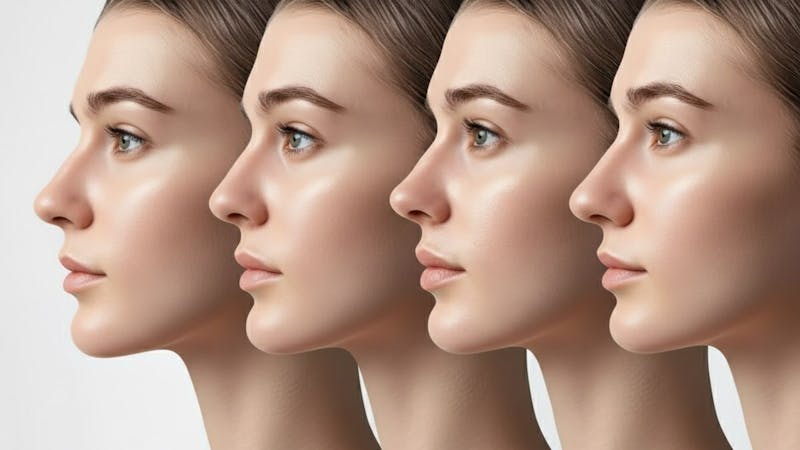
For both men and women, rhinoplasty isn’t about trends. It’s about balance - the quiet kind that makes a face look harmonious and natural.
Dr. Michael Baumholtz, dual board-certified in Plastic Surgery and General Surgery, treats rhinoplasty as a conversation between structure and identity. He listens first, studies proportion from multiple angles, and builds a plan that fits the person - not a template.
His constant equation:
What the patient wants + what can be safely delivered = a plan built to last.
Why Shape Matters More Than Size
“Can you make it smaller?” is common. The issue is usually proportion, not just size. A nose that looks right on one face can distract on another. The aim is for the nose to blend so attention returns to the eyes.
For most faces, that means:
- A bridge aligned with the brow
- A tip with gentle definition (not sharp or pinched)
- A base that fits the midface
- A profile that considers chin projection
It’s not about making the nose disappear - it’s about making it belong.
Common Nose Shapes (and What Can Help)
Every shape has its own structure. These are patterns Dr. Baumholtz commonly sees in his San Antonio practice. Plans are individualized after an in-person exam.
- Dorsal Hump (Aquiline Profile)
- What patients notice: A bump on the bridge, most obvious in profile.
- Approach: Smooth the hump, then rebuild internal support (often with spreader graft concepts) to keep the airway strong and the bridge stable.
- Result goal: A smooth, natural contour - not an over-flattened "ski slope."
- Bulbous Tip
- What patients say: Round, undefined, "ball-like."
- Approach: Precise cartilage refinement with suture techniques and gentle support grafts.
- Thicker skin: Definition appears gradually as swelling settles.
- Goal: Subtle, refined shape without a pinched look.
- Wide Bridge or Wide Base
- What patients see: Broadness from the front view.
- Approach: Controlled bone work (osteotomies) to narrow the bridge; base narrowing only when nostril width truly distracts.
- Principle: Keep character - avoid over-narrowing that looks artificial.
- Downturned Tip
- What patients see: A tip that dips at rest or drops more with smiling.
- Approach: Gentle rotation and internal support so the tip stays steady in motion.
- Result goal: A relaxed, approachable expression.
- Upturned or Short Nose
- What patients see: More nostril show and a shorter appearance.
- Approach: Subtle lengthening and counter-rotation with reinforced support.
- Goal: Restore maturity and balance while preserving identity.
- Crooked or Deviated Nose
- What patients see: Asymmetry from the front and a bent profile.
- Approach: Straighten the internal framework first; address septal deviation when present.
- Bonus: Airflow can improve when structure is centered.
- Thick-Skinned Nose
- What patients see: Softer edges and limited definition.
- Approach: Build stronger support beneath and allow definition to emerge over time.
- Note: Patience pays off - true shape declares over months.
For Men and Women, Goals Differ - But Principles Don’t
- Women often ask for refinement: a smoother bridge, a lighter-feeling tip, and a profile that softens.
- Men often want structure: a straighter bridge, balanced width, and results that look strong, not sculpted.
Dr. Baumholtz tailors each plan to the individual’s anatomy, gender expression, and lifestyle - not one standard of beauty.
Function and Form Go Hand-in-Hand
A nose that looks good but doesn’t breathe well isn’t a success. Functional anatomy is part of every plan. He evaluates:
- Internal valve support (to prevent collapse after dorsal changes)
- Septal straightness
- Turbinate size and airflow
When obstruction is reported, these issues can often be addressed during the same operation.
His Approach: Structure, Safety, and Substance
- Open Approach for Precision
The small incision between the nostrils (columella) usually heals as a fine line. This exposure allows accurate measurements and precise adjustment of the tip and support structures. - Structural Reinforcement
Cartilage grafting builds durability - using a patient’s septal cartilage when available. If more support is needed, carefully shaped ear or rib cartilage - including cadaveric rib when appropriate - may be considered. Synthetic nasal implants are rarely used. - Conservative Change
Less can be more. Natural, believable outcomes tend to age better than trendy extremes. - Balance With the Chin
A small chin can make a normal-sized nose look larger. Chin enhancement is optional and discussed separately. The goal is facial harmony, not "more surgery." - Anesthesia & Safety
Rhinoplasty is performed under general anesthesia with a board-certified anesthesiologist.
All surgery carries risk. Possible risks include bleeding, infection, asymmetry, prolonged swelling, scar concerns, changes in sensation, and the potential need for revision. Decisions are made case-by-case after an in-person evaluation. No outcomes are guaranteed.
Recovery in San Antonio: Realistic and Structured
- Most rhinoplasties are outpatient.
- Swelling and bruising are expected and improve in stages.
- Sleep elevated, avoid bumping the nose, and follow instructions closely.
- Internal splints: about 1 week.
- External splint: about 1-2 weeks.
- Glasses/frames: Keep off the bridge until cleared.
- Exercise/contact sports: Gradual return per the follow-up plan.
- Heat and allergies: South Texas heat and seasonal allergies can slightly prolong swelling; timing and aftercare are adjusted as needed.
Follow-up cadence: Typically about 1 week, about 2 weeks, then as needed.
Dynamic planning: He evaluates smiling and expressions so support holds up in real life - talking, laughing, and exercising.
The Long View: Build It to Last
Good rhinoplasty doesn’t fight a face - it fits a life. Patients often report fewer distractions in photos and easier breathing when function was part of the plan. He designs noses that:
- Look right from multiple angles
- Hold shape through motion and time
- Reflect the patient’s identity, not a trend
Results vary by anatomy and healing. Goals, plan, and timeline are reviewed together.
The Value of a Thoughtful Plan
Cosmetic rhinoplasty is typically self-pay. Fees reflect surgical time, facility, and anesthesia - and the surgeon’s involvement before and after.
Dr. Baumholtz does not take insurance.
Value comes from alignment: your goals + a clear plan + realistic healing = durable results.
FAQs for First-Time Rhinoplasty Patients
Will Texas allergies affect healing?
They can. Surgeries are often scheduled around allergy peaks, with saline care and conservative, surgeon-approved anti-inflammatory strategies.
When can I wear glasses again?
Usually after several weeks - once swelling and bridge sensitivity improve and your surgeon clears direct pressure.
Do men heal differently than women?
The process is similar. Men may have thicker skin and stronger cartilage, which can make visible refinement take a bit longer.
Can I keep my family's distinctive nose shape?
Yes. The aim is refinement without erasing authentic features. Plans are specific about what to keep and what to soften.
Open vs. closed rhinoplasty - why prefer open?
He often prefers an open approach for precise, structural work and reliable visualization, especially for tip definition and support.
Will I need ear or rib cartilage?
Most primary cases use septal cartilage. If more support is needed, ear or rib cartilage - including cadaveric rib - may be recommended for durability. Synthetic nasal implants are rarely used.
What This Page Is - and Isn't
- Is: Plain-English guidance on how shape and proportion guide rhinoplasty planning in his San Antonio practice.
- Isn't: A promise of a specific appearance or a substitute for an in-person consultation.
Medical References
- Rhinoplasty. Mayo Clinic. https://www.mayoclinic.org/tests-procedures/rhinoplasty/about/pac-20384532
- Otorhinolaryngology/Ear, Nose & Throat. Mayo Clinic Health System. https://www.mayoclinichealthsystem.org/services-and-treatments/otorhinolaryngology
- Facial Plastic and Reconstructive Surgery. Mayo Clinic Research. https://www.mayo.edu/research/departments-divisions/department-otorhinolaryngology/divisions/facial-plastic-reconstructive-surgery
- Hit it on the nose: Deviated septum Q&A. Mayo Clinic Health System. https://www.mayoclinichealthsystem.org/hometown-health/speaking-of-health/hit-it-on-the-nose-deviated-septum-q-and-a
- Current Surgical Outcomes of Nasal Tip Grafts in Rhinoplasty. Elsevier Pure (Mayo Clinic publication). https://mayoclinic.elsevierpure.com/en/publications/current-surgical-outcomes-of-nasal-tip-grafts-in-rhinoplasty-a-sy
- Nose: Applied Aspects in Dermatology. PubMed Central. https://www.ncbi.nlm.nih.gov/pmc/articles/PMC4817463/
- Investigating the case of human nose shape and climate. PubMed Central. https://www.ncbi.nlm.nih.gov/pmc/articles/PMC5354252/
Ready to Talk About Your Nose Shape?
If the goal is fewer distractions and better balance - without losing what feels authentic - start with a conversation.
Call Baumholtz Plastic Surgery in San Antonio or request an appointment online with Dr. Michael Baumholtz. Bring your top two priorities. He’ll bring a clear plan, a steady process, and a focus on safety.
Further Reading
- Read more about Face Procedures
- Read Dr Baumholtz's Blog on What to Expect During Your Rhinoplasty Recovery


